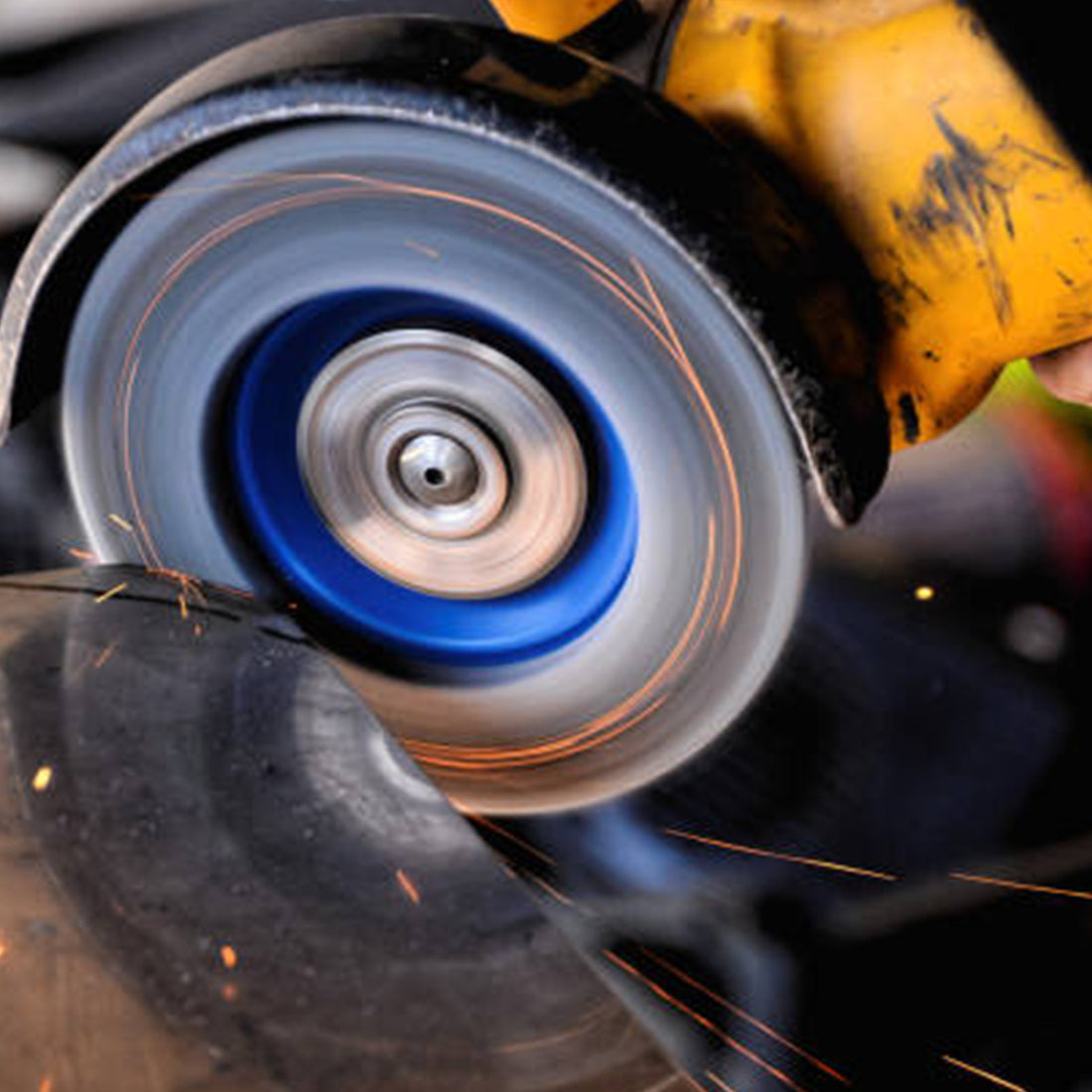In the field of hardware tools, low-speed grinding wheels excel in applications requiring detailed finishing and reduced heat buildup. These wheels not only offer greater precision in control during use, but can also significantly extend the life of the wheel. Next, the selection and application of low-speed grinding wheels will be discussed in detail, as well as some recommended models and parameters will be provided to offer valuable information to readers.
Advantages of Low Speed Grinding Discs
Low speed grinding discs have the following outstanding advantages:
1.Reduction of Heat Buildup :
Low-speed rotation reduces the heat generated by friction, thereby preventing overheating and deformation of the material surface. This is particularly important for temperature-sensitive materials such as high-carbon steel and tool steel, which tend to harden and crack with excessive heat.
2.Higher Control Precision :
The low speed allows operators to have better control over the grinding process, making it ideal for fine finishing and polishing work. For example, in woodworking and furniture making, low speed discs can be used to sand and polish wood with outstanding results.
3.Extended Disk Life :
Reducing the speed decreases wear on the disc, thus prolonging its service life. This not only reduces operating costs, but also decreases the frequency of disc replacement, improving work efficiency.

Application Scenarios
Low speed grinding discs are especially suitable for the following scenarios:
- High Carbon Steel and Tool Steel : These materials tend to harden and crack with heat, and low speed grinding can avoid these problems while maintaining the original properties of the material.
- Woodworking and Furniture Making : In these fields, low speed grinding discs are used for fine sanding and polishing of wood, effectively removing rough parts from the surface and improving the quality of the final product.
- Sharpening Tools and Blades : Low speed rotation can maintain the sharpness of tools, preventing excessive wear and extending the life of the tools.
Grinding Disc Selection Guide
1. Hardness and Granulometry
Choosing the right hardness and grit size of the grinding wheel is crucial. Generally, wheels with lower hardness are suitable for soft materials, while harder wheels are suitable for hard materials. In terms of grit size, coarse grits are suitable for roughing work, while fine grits are ideal for finishing. For example, when working with high-carbon steel, using a wheel with high hardness and fine grit can offer better grinding results.
2. Material
Grinding discs are made of various materials, such as aluminum oxide, silicon carbide, and diamond. Aluminum oxide discs are suitable for steel materials, while silicon carbide discs are ideal for carbide and ceramic materials. Choosing the right material can improve grinding efficiency and the quality of the finished product. For example, aluminum oxide discs are excellent for working with steel materials, while silicon carbide discs are suitable for hard materials.
3. Speed
Low speed grinding discs typically operate below 1800 RPM, making them ideal for fine sanding and polishing. The lower the speed, the smoother the grinding process, making them perfect for high precision tasks and smooth finishes.
Comparative Data Table
Below is a comparison table of the parameters of some common low-speed grinding discs (all sizes in inches):
| Model | Diameter (in) | Thickness (in) | Material | Maximum speed (RPM) | Applicable Materials |
|---|---|---|---|---|---|
| Norton SG 5 | 6 | 1 | Aluminum Oxide | 1725 | Steel |
| 3M Cubitron II | 8 | 1.25 | Aluminum Oxide | 1800 | High Carbon Steel, Tool Steel |
| Weiler Tiger | 7 | 0.75 | Silicon Carbide | 1500 | Carbide, Ceramic |
| DEWALT DW4945 | 9 | 1.5 | Aluminum Oxide | 1600 | Steel |
Recommended Models and Parameters
According to different application needs, below are some recommended models of low-speed grinding discs and their parameters:
1.Norton SG 5 :
Suitable for fine finishing and polishing of general steel materials, with a diameter of 6 inches, a thickness of 1 inch and a maximum speed of 1725 RPM. This grinding disc performs exceptionally well in low speed operations, effectively reducing heat build-up and being ideal for long-term continuous work.
2.3M Cubitron II :
Suitable for fine processing of high carbon steel and tool steel, with a diameter of 8 inches, a thickness of 1.25 inches and a maximum speed of 1800 RPM. Its advanced abrasive technology ensures high grinding performance, while prolonging the life of the disc.
3.Weiler Tiger :
Suitable for grinding carbide and ceramic materials, with a diameter of 7 inches, a thickness of 0.75 inches and a maximum speed of 1500 RPM. This grinding disc features excellent wear resistance and high grinding performance, making it ideal for high hardness materials.
4.DEWALT DW4945 :
Suitable for roughing and finishing of general steel materials, with a diameter of 9 inches, a thickness of 1.5 inches and a maximum speed of 1600 RPM. Its wide diameter and thickness make it highly efficient in processing large areas of material.

Tips for Use
When using low speed grinding discs, the following tips can help improve grinding results and extend tool life:
1.Maintain Proper Pressure :
Excessive pressure will increase friction and heat, causing excessive wear on the disc and material. Maintaining proper pressure will not only improve grinding efficiency, but will also extend disc life.2.Inspect the Disc Regularly :
During use, regularly inspect the wear status of the disc and replace it in time if it is worn or damaged to ensure grinding efficiency and safety.
3.Use Coolant Correctly :
Using coolant when necessary can effectively reduce heat buildup during the grinding process, protecting the material and the disc, especially when working with temperature-sensitive materials.Conclusion
Low-speed grinding wheels have significant advantages in specific applications, including reduced heat buildup, improved control accuracy, and extended service life. Selecting the right grinding wheel involves considering factors such as hardness, grit size, material, and speed. With the detailed guidance and recommendations provided, it is hoped that readers will be able to select and use low-speed grinding wheels more efficiently and effectively.

